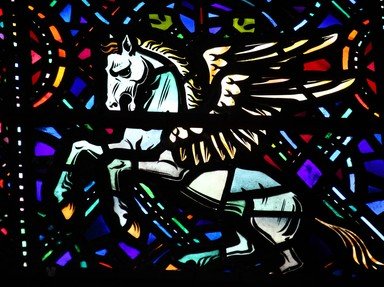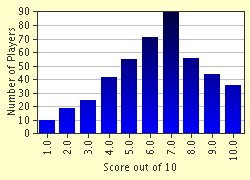Quiz Answer Key and Fun Facts
1. The Greek and Norse mythologies are two of the most profoundly poetically analyzed mythologies. They both bring forth detailed and original cosmogonies as well as interesting and complex pantheons of gods. Relating to the first aspect, it must be said that almost all mythologies suggest their own view (more or less original and meaningful) about the birth of the Universe. Thus, the Norse cosmogony begins with a primordial stage consisting of two areas: Niflheim (realm of mist) and Muspellsheim (realm of fire), delimited by a barren neutral zone called Ginunga Gap. After eons, the frozen mist touches the flames and so the first live form arises - Ymir (the Frost Giant).
Greek mythology has a rather simplified genesis story. In the beginning there was Chaos. Who (what) came into being from this eternal darkness?
2. Zeus' triumph over the Titans brought him unlimited power, but he still agreed to share the rule of the Universe with his older bothers. After Zeus picked the sky as his eternal, glorious throne, Poseidon and Hades had to settle for the Sea and the Underworld.
But how about the Norse mythology? Into how many worlds did Odin find best suited to separate his Universe?
3. Zeus commissioned the Cyclopes to build him a majestic palace on the haughtiest cliff of Mount Olympus. His impetuous residence would be a place of delight, where all the gods desired to be, feasting on ambrosia and nectar.
On the other side, what was the name of Odin's heavenly palace?
4. Both the Norse and the Greek mythologies have second "versions", materializing in the Germanic and respectively Roman mythologies, which inherit almost all the elements of their conterparts. As Odin is called Wotan in German myths, so is Zeus translated in the Roman pantheon as ...
5. One of the most original and controversial Norse deities is Loki, the god of Fire - a force both tempestuous and creative. He is Odin's blood brother and his presence in the pantheon assures the poise of contraries needed to stabilize the universe. Loki takes part in the primordial creation act, inoculating the passion flame in the hearts of the first mortals. He is cunning, resourceful, bragging, immoral and a scrupulous liar. A mischief-maker, Loki is banished by the gods after murdering Baldr (the god of youth) with a mistletoe branch. Odin punishes him for this awful sin, bounding him to three slabs under a serpent dripping poison over his body. Trapped in this tormenting prison, Loki's only goal is to get his revenge on Odin, so he untiringly plots against Ashgard. His schemes would eventually ignite Ragnarokr - the twilight of gods.
Surprisingly, many of the elements in Loki's story are to be found associated with one particular deity from Greek mythology. Which one?
6. A splendid Greek myth is the legend about Jason and his search for the Golden Fleece. Jason was to become the king of Iolkos in succession to his father, but his uncle Pelias usurps the throne and takes the power for himself. When Jason reaches maturity he comes before his uncle and demands his rightful throne back. The cunning Pelias complies with this request, but asks in exchange the Golden Fleece. Thus, Jason forms an expedition and sets sail for Colchis, where the precious artifact was located. Jason's companions for this dangerous quest are not ordinary men, but 53 of the greatest heroes in all of Greece: Herakles, Orpheus, Castor, Pollux, Meleagros, Peleus, Laokoon, Ankaios and many others. They would further be known as the Argonauts from the name of their ship, Argo. After countless adventures, the Argonauts reach Colchis, where they would be submitted to yet new challenges from the ruler of the land, king Aeetes. Their powers alone aren't enough and in order to succeed they need the help of the beautiful sorceress Medea, who felt in love with Jason. With her guidance, the Argonauts manage to steal the Golden Fleece, after slaying the dragon that was guarding it. Jason return to Iolkos with the Golden Fleece and then marries Medea. Their story would be a tragic one though, since Medea delivers a cruel revenge on Jason, for deserting her.
A golden treasure is also the wheel that drives the legend of the Niebelungs from Norse (Germanic) mythology. What famous hero went in search of this cursed treasure?
7. Greek myths owe a great deal of their particular charm to the fantastic monstrous creatures that dwell in dreaded and foul places. Hydra, Scylla, Charybdis, Chimera, Typhoon, Echidna are all hideous beasts, terrorizing the uncharted regions of the mortal world.
Norse mythology has its share of monsters. The best known example is probably the ancient dragon of the Nifleheim realm (the lowest level of the Universe) that arises during Ragnarok. What's the name of this winged "nightmare"?
8. The Ancient Greeks and in their turn the Norse were warring peoples. Thus, the gods of war are among the key figures in both pantheons. They are both the sons of the supreme gods, Zeus and Odin respectively. The Norse god of war is Tyr, who is renowned for his courage. He is depicted as having only one hand, the other one having been bitten off by the wolf Fenris. Tyr is believed to have been the original supreme god in Norse mythology, but his attributes were gradually transferred to Odin. Still, Tyr's importance is obvious, as he gave his name to a day of the week in Germanic languages (Tuesday).
Who was Tyr's counterpart in Greek mythology? (A remarkable coincidence is the fact that the Roman name of this god gave the name of the same day of the week, but in the Latin languages).
9. Although Odin and the other Norse gods possessed unlimited power, their destinies are still irrevocably sealed by the will of the Norns. The Norns are three maidens called Urdhr (the past), Verdhandi (the present) and Skuld (the future) and are said to visit each and every being after birth, gods and humans alike, setting the course of their lives. The Norns survive Ragnarokr because they are eternal and omniscient.
Who are the almost identical correspondents of the Norns in Greek mythology?
10. Greek myths speak of a great flood that nearly put an end to humanity. However, a truly complex and distinctive vision about the destruction of the entire universe is depicted in the Norse mythology. What is this catastrophic event called?
Source: Author
Mr5
This quiz was reviewed by FunTrivia editor
agony before going online.
Any errors found in FunTrivia content are routinely corrected through our feedback system.


